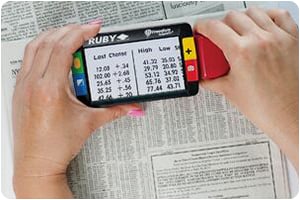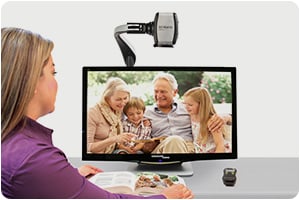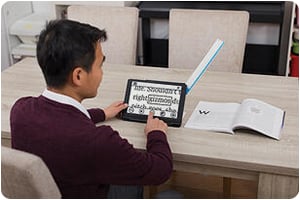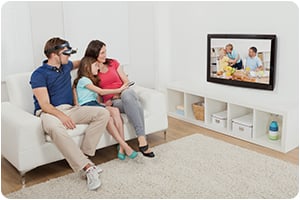Featured On




Did you know?
Blindness and Low Vision impact over 282 Million people globally and that number is expected to increase by 72% over the next 11 years? There are 7.2M visually impaired adults in the United States.
What is low vision?
Low vision is a visual impairment that cannot be fully corrected with regular eyeglasses, contact lenses, medication or surgery. Despite all conventional treatment, vision remains blurred or distorted, and it interferes with the ability to perform everyday activities such as reading, writing, and shopping. Millions of Americans lose some of their vision every year due to a variety of eye conditions such as Glaucoma, Cataracts, Macular Degeneration, Diabetic Retinopathy, or Retinitis Pigmentosa.
What can be done for low vision?
It is uncommon and rare to restore—in its entirety—vision that is lost. Vision specialists can determine whether the loss of vision experienced is normal due to aging, or if it is caused by other sources such as eye disease. A vision specialist can also help to determine if a vision rehabilitation program would be beneficial to an individual with low vision.
There are a number of products that can help individuals with low vision. While considering the correct visual aid, keep in mind a few objectives:
- What tasks will the visual aid be used for? Certain low vision products will be tailored to the task at hand more than others. Start by determining the best use for each product, then decide if it will meet the needs of the individual.
- What is the visual ability of the individual? Low vision aids are created with different options for specific low vision needs. For each individual, there is a unique set of circumstances to be considered surrounding their visual abilities, so it is very important to ask about the different features each device offers before making a selection.
- Is the device easy to use? As with any other device you add into your routine, there might be a small learning curve, but the right device should be relatively easy for you to use.
What is the difference in video magnifiers?
Video Magnifiers come in a variety of form factors whether you need one on the go, at home or even ones that read the text to you aloud when your eyes become fatigued.
 Portable Magnifiers offer magnified reading on the go. Perfect for menus, shopping lists, label reading, and more. These compact portable magnifiers can fit in your pocket, purse, or be worn on the belt for quick, easy use. Designed with a built-in rechargeable battery, they can offer up to 3hrs of continuous use before needing to be recharged. Most offer a generous adjustable magnification range and adjustable color contrast for a truly customized viewing experience. Portable magnifiers typically include their own lighting, making it possible to magnify print and images in any type of lighting.
Portable Magnifiers offer magnified reading on the go. Perfect for menus, shopping lists, label reading, and more. These compact portable magnifiers can fit in your pocket, purse, or be worn on the belt for quick, easy use. Designed with a built-in rechargeable battery, they can offer up to 3hrs of continuous use before needing to be recharged. Most offer a generous adjustable magnification range and adjustable color contrast for a truly customized viewing experience. Portable magnifiers typically include their own lighting, making it possible to magnify print and images in any type of lighting.
 Desktop Magnifiers have large, bright screens and typically include a reading table for a more seamless experience. The larger footprint also allows you to read larger materials such as books or newspapers or do hobbies such as sewing or crosswords. One of the many additional features of a desktop magnifiers is optional computer connectivity, which allows you to toggle between magnified images and what is on your computer. Some models have cameras that rotate so you can see yourself, making it ideal for applying makeup or self-grooming. These electronic magnifiers are perfect for close-up viewing as well as distance viewing.
Desktop Magnifiers have large, bright screens and typically include a reading table for a more seamless experience. The larger footprint also allows you to read larger materials such as books or newspapers or do hobbies such as sewing or crosswords. One of the many additional features of a desktop magnifiers is optional computer connectivity, which allows you to toggle between magnified images and what is on your computer. Some models have cameras that rotate so you can see yourself, making it ideal for applying makeup or self-grooming. These electronic magnifiers are perfect for close-up viewing as well as distance viewing.
 Multiple Use Magnifiers can address multiple needs with the help of innovative accessories. For example, a handheld magnifier may have accessories that convert it into a scan and read device. By simply placing the magnifier on a docking stand, you can have a full-page document read back to you with a simple push of a button, allowing your eyes to rest. Other handheld magnifiers can be placed in a wearable accessory that is worn like a pair of glasses, giving the user a hands-free distance viewing or reading experience. Still, others provide a forward-facing camera so that the user can see objects at a distance as well as ones directly in front of them. As technology continues to advance, we’ll see that one product may able to solve many issues.
Multiple Use Magnifiers can address multiple needs with the help of innovative accessories. For example, a handheld magnifier may have accessories that convert it into a scan and read device. By simply placing the magnifier on a docking stand, you can have a full-page document read back to you with a simple push of a button, allowing your eyes to rest. Other handheld magnifiers can be placed in a wearable accessory that is worn like a pair of glasses, giving the user a hands-free distance viewing or reading experience. Still, others provide a forward-facing camera so that the user can see objects at a distance as well as ones directly in front of them. As technology continues to advance, we’ll see that one product may able to solve many issues.
 Wearable Magnifiers offer the same features as a desktop or portable magnifier but can be worn like a pair of glasses. This provides a hands-free experience that is ideal for sporting events, movies, watching television, working on hobbies and seeing loved ones. They also allow you to read a newspaper or magazine hands-free. Wearable magnifiers are an ideal solution for someone with an active lifestyle. Often very compact, they can easily be transported to use in any environment without sacrificing any of the essential features of a traditional desktop magnifier such as adjustable magnification or color contrast.
Wearable Magnifiers offer the same features as a desktop or portable magnifier but can be worn like a pair of glasses. This provides a hands-free experience that is ideal for sporting events, movies, watching television, working on hobbies and seeing loved ones. They also allow you to read a newspaper or magazine hands-free. Wearable magnifiers are an ideal solution for someone with an active lifestyle. Often very compact, they can easily be transported to use in any environment without sacrificing any of the essential features of a traditional desktop magnifier such as adjustable magnification or color contrast.
For more information contact us at: (877) 556-8390